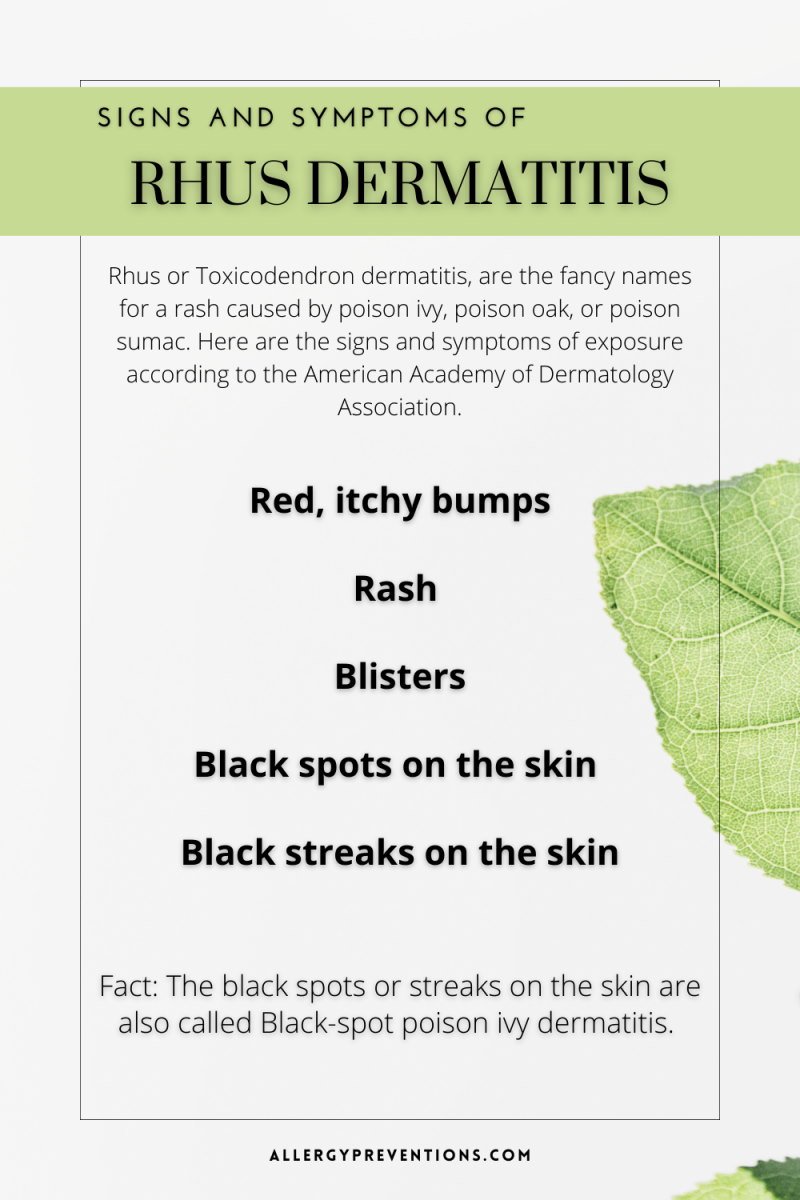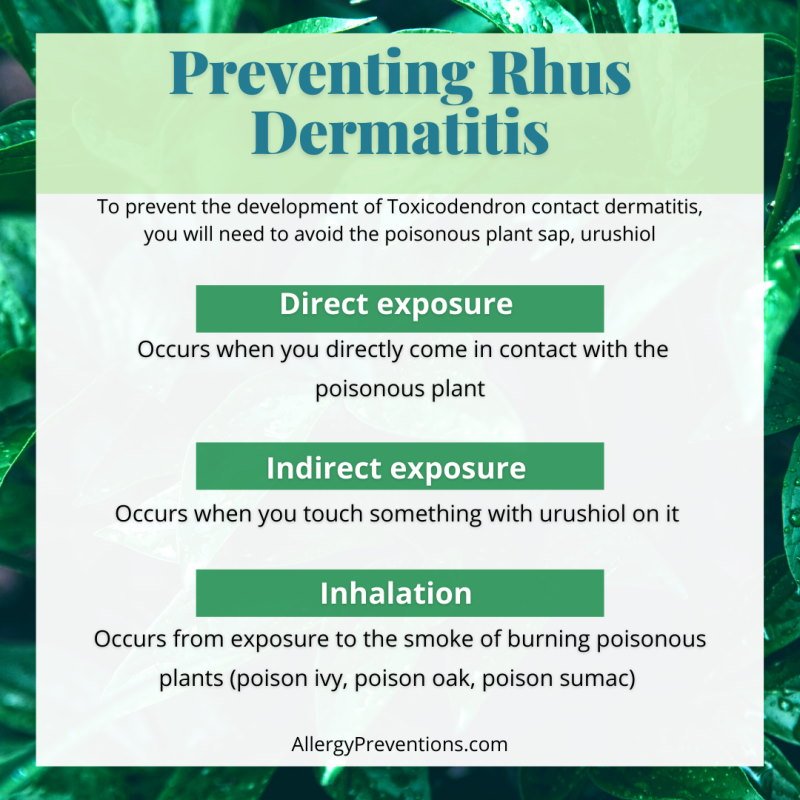What if you could learn everything you wanted to know about Rhus dermatitis in 10 minutes or less? Well, you are about to! This article provides you with everything you need to know about Rhus dermatitis. Having a better understanding of this condition will put your mind at ease.
You will leave here knowing the causes, symptoms, treatment options, and more.
This information is for those with Rhus dermatitis, or anyone who is curious about the matter. Whether you suffer from Rhus dermatitis or have a severe allergy when you come in contact with certain plants, this information is for you.

As an Amazon Affiliate, I may earn compensation on qualifying purchases.
Rhus Dermatitis Has Another Name
Did you know that “Rhus Dermatitis” is the old term, and the new term is now Toxidendron Dermatitis?
Since the term “Rhus” is being phased out, we will be using both terms interchangeably.
Other Possible Names for Rhus Dermatitis
- Toxicodendron Dermatitis
- Toxicodendron Dermatitides
- Contact Dermatitis
- Urushiol Dermatitis
- Urushiol-Inducted Contact Dermatitis
- Poison Ivy Dermatitis
- Poison Ivy Rash
- Sumac Dermatitis
- Poison Oak Dermatitis
- Poison Oak Rash
- Rhus Dermatitides
What is Rhus Dermatitis?
According to NCBI, Rhus or Toxicodendron dermatitis is an allergy reaction on your skin when you have been exposed to the sap-like substance “urushiol”.
Causes of Toxicodendron (Rhus) Dermatitis
The cause of Rhus dermatitis is exposure to Urushiol which is found in poison ivy, poison oak, and poison sumac.
You may be exposed to urushiol when you brush against one of the plants containing the oily sap, or if you are near the smoke of the plants if they are being burned.
The burning of Toxicodendron plants can make the irritant become airborne and cause irritation to the eyes, nose, and lungs.
What is the Allergen in Rhus Dermatitis?
The reactive agent is an irritant called urushiol (oleoresin). Urushiol is a sticky plant oil that causes skin inflammation and irritation. This chemical irritant is found in Toxicodendron (formerly Rhus) plants.
Since urushiol is a chemical irritant, most people will react when exposed. Depending on your individual sensitivity to this agent, you may have minor to severe reactions.
Signs and Symptoms of Rhus Dermatitis

Rhus or Toxicodendron dermatitis, are the fancy names for a rash caused by poison ivy, poison oak, or poison sumac. Here are the signs and symptoms of exposure according to the American Academy of Dermatology Association.
- Red, itchy bumps
- Rash
- Blisters
- Black spots on the skin
- Black streaks on the skin
Fact: The black spots or streaks on the skin are also called Black-spot poison ivy dermatitis.
Clinical Manifestations
The AAFP explains the typical clinical manifestation of contact dermatitis (Rhus or Toxicodendron) as:
- Itching
- Discomfort
- Erythema flare
- Vesicle flare
- Bullae flare
- Lichen with cracks and fissures
Poison Ivy Rash Stages

The stages of poison ivy, poison oak, and poison sumac (Rhus/Toxicodendron dermatitis) are initial exposure, itching begins, the rash develops, rash subsides.
- Initial exposure: You have made contact with the poisonous plant
- Itching begins (immediate – 1 hour): The skin becomes extremely itchy, without a rash
- Rash develops (2 hours – 3 weeks): A red and itchy rash, possibly with blisters
- Rash subsides (2 – 3 weeks): Rash begins to clear up, blisters crust and heal.
You might be wondering how the rash can develop 3 weeks after exposure? AAD.org explains that this typically happens when it is your first exposure to urushiol (sap causing irritation).
Diagnosis
The diagnosis of Rhus dermatitis or allergy to poison ivy, poison oak, or poison sumac is straightforward. Your physician will complete a physical exam and go over your medical history.
Additionally, your doctor may ask these types of questions to confirm the diagnosis.
Diagnosing Rhus Dermatitis Example Questions
- What are your symptoms?
- When did your symptoms start?
- Have you experienced this rash before?
- Were you working outside or in the woods?
- Have you been in contact with anyone working outside?
Treatments
Most cases of Rhus dermatitis can be treated at home. Most cases of poison ivy, poison oak, or poison sumac exposure self-resolve in about 3 weeks without any treatment. These treatment recommendations are directly from the FDA.
How to Treat
- Do not scratch the rash or blisters
- Apply a cold, wet compress
- Use an over-the-counter topical corticosteroid (Cortizone 10)
- Try Calamine lotion
- Apply an astringent with aluminum acetate
Aluminum Acetate Astringent Recommendation

If you are interested in trying out an astringent, here is the best one I could find on Amazon, and it’s called Tricalm Hydrogel.
Quick Facts
- No side-effects
- Steroid-free
- Soothes poison ivy, shingles, hives, and more
If these home remedies do not work, you are getting new symptoms, or symptoms are becoming severe, it may be time to seek professional medical help.
When to See a Doctor
You will need to seek medical care for treatment if any of these signs or symptoms apply to you.
- Body temperature exceeding 100 degrees Fahrenheit (33.77 degrees Celsius)
- Trouble breathing
- Evidence of pus
- Soft yellow scabs
- Tender rash
- Increased itchiness
- Losing sleep due to symptoms
- Spreading rash to eyes, nose, mouth, or genitals
- Rash covering 25% or more of your body
- No improvement within 3 weeks
Chronic Rhus Dermatitis
Rhus dermatitis can take around 3 weeks to resolve. If it has not been 3 weeks since your contact dermatitis began, it is considered acute.
Rhus dermatitis that has lasted more than 3 weeks (chronic) may be caused by repeat exposure to the poisonous sap, urushiol.
Prevention

To prevent the development of Toxicodendron contact dermatitis, you will need to avoid the poisonous plant sap, urushiol. You may be exposed directly, indirectly, or from inhalation.
Direct exposure – occurs when you directly come in contact with the poisonous plant
Indirect exposure – occurs when you touch something with urushiol on it
Inhalation – occurs from exposure to the smoke of burning poisonous plants (poison ivy, poison oak, poison sumac)
How to Limit and Prevent Rhus Dermatitis
- Cover your skin
- Long sleeve shirts
- Pants (not shorts)
- Boots
- Gloves
- Use special skin creams that provide a barrier
- Prevent indirect exposure
- Change clothes before going inside or into a vehicle
- Clean all urushiol-exposed equipment
- Consider using disposable gloves/cover-alls
- Do not burn poisonous plants
- If unavoidable, wear a NIOSH-certified respirator (R-95, P-95, or better)
This information is from the Department of Health and Human Services.
IvyX® Pre and Post Poison Ivy Solution
IvyX Brand sells a pre and post-contact solution kit, so you are covered no matter what happens.

Toxicodendron Plants
The following plants are direct “children” of Toxicodendron Mill (poison ivy, poison oak), as outlined by the Integrated Taxonomic Information System.
Toxicodendron Plant Species
- Toxicodendron diversilobum – Pacific poison oak
- Toxicodendron pubescens Mill. – poison oak, Atlantic poison oak
- Toxicodendron radicans – poison ivy, eastern poison ivy
- Toxicodendron rydbergii (Small ex Rydb.) – poison ivy, western poison ivy
- Toxicodendron succedaneum – wax tree
- Toxicodendron vernicifluum – Chinese lacquer
- Toxicodendron vernix – poison sumac
What do the plants that cause Rhus dermatitis look like?
The FDA has a great 2.5-minute video that explains what poisonous plants look like. Additionally, the video covers tips for preventing contact dermatitis rashes and blisters.
Rhus Dermatitis FAQs
How long does a rash from poison ivy, oak, or sumac last?
1 – 3 weeks. The rash should clear up in about 3 weeks. Source: PennMedicine.
Is Rhus dermatitis contagious?
No. This type of rash (contact dermatitis) is not contagious.
What is the ICD 10 code for Rhus Dermatitis?
L23.7. ICD-10 code L23.7 is for allergic contact dermatitis due to plants, except food.
Should I pop poison ivy blisters?
No. Popping any sort of blisters can lead to worsening symptoms or infection.
Do antihistamines like Benadryl help with Rhus dermatitis?
Yes. taking an antihistamine can ease the itch and help you sleep better.
Does hydrocortisone cream help with poison ivy, oak, and sumac?
Yes. Hydrocortisone helps relieve minor itching, inflammation, and rashes on the skin.
Does Calamine lotion work on poison ivy, poison oak, and poison sumac?
Yes. Calamine lotion dries the oozing and weeping associated with all of these conditions.
What are Rhus Tox Supplements?
Rhus Tox supplements are a homeopathic medication used to treat joint pain.
Next Up
That should be everything you wanted to know about this not-so-fun contact dermatitis!
Be sure to check out these articles for even more related content.
